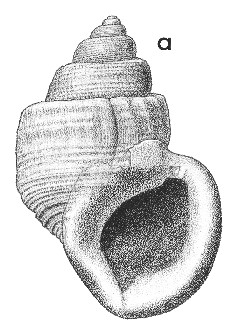
Revised descriptions of New Zealand Cenozoic Mollusca from Beu and Maxwell (1990)

 | Revised descriptions of New Zealand Cenozoic Mollusca from Beu and Maxwell (1990) | 
|
  (Pl. 42a): GS10849, V20/f8572, Devil's Elbow mudstone (highest siltstone unit of Tangoio-Devil's Elbow sequence) on north face of Devil's Elbow hill, Napier-Wairoa highway, late Nukumaruan (GNS) |
Beu & Maxwell (1990): Chapter 15; p. 321; pl. 42 a.
Synonymy: Struthiolaria fossa Marwick 1924b, p. 189
Classification: Struthiolariidae
Description: Moderately small to large for genus (35-50 mm high), with short to moderately tall spire (markedly to slightly shorter than aperture), wide, slightly concave to deeply channelled sutural ramp, evenly convex whorls on early spire but vertical whorl sides and a weak peribasal angulation on last whorl, and normal, wide Pelicaria aperture with weakly sinuous, varicate outer lip meeting thick, smooth inner lip at shallow anterior notch. Sculpture of many low, narrow, closely spaced spiral cords on early spire, variable in development lower on shell; most specimens with only low, narrow, widely spaced spiral threads on whorl sides, but more strongly corded base, with only weak axial growth ridges, but some with more prominent spiral cords and weak nodules below shoulder. Protoconch typical of genus (see P. vermis from convexa).
Comparison: Pelicaria vermis form fossa seems to evolve gradually from P. vermis form convexa in the mid-late Nukumaruan Devil's Elbow-Darkys Spur-Tangoio Valley sequence, north of Napier. Typical specimens of P. vermis form convexa, with evenly convex whorls and no subsutural platform, occurs (intergrading with rare P. vermis form acuminata) in siltstone at the base of the sequence, in both Tangaio Valley in the south of the area and Arapaoanui River in the north. Highly developed specimens of P. vermis form fossa, with vertical whorl sides and a deep, wide subsutural channel, occur in the two highest siltstone units in the sequence (Te Ngaru Mudstone and Devil's Elbow Mudstone; Beu 1995); and intermediate populations, with a gradually developing sutural channel, occur in the two intervening siltstone units. However, on Kereru Road near the bridge over Okauawa Stream, inland central Hawke's Bay, a thick mudstone unit with abundant specimens of P. vermis form fossa is interbedded with two thin, shallow-water, sandier beds containing common large specimens of P. vermis form convexa with a very narrow sutural shelf (type locality of P. convexa). This demonstrates that P. fossa is a late Nukumaruan offshore ecomorph of P. vermis form convexa. The basin was sinking faster than it was being filled with sediment, so that each successive siltstone unit (deposited during the interglacial, high sea-level part of each glacio-eustatic cycle) was deposited in progressively deeper water. It is clear that gradation in the Devil's Elbow section from P. vermis form convexa to P. vermis form fossa is an ecological rather than an evolutionary succession, contributing further to the concept that all Nukumaruan and younger forms belong in the single species P. vermis.
Distribution: Nukumaruan; "Shrimpton's", Kikowhero Stream, Matapiro Station, north of Ngaruroro River, central Hawke's Bay (type); widespread and, at some localities, extremely abundant in blue-grey siltstone in central Hawke's Bay (particularly in the Tangoio-Devil's Elbow block, north of Napier, and in the Okauawa Stream-Mangatahi River area, Kereru Road, west of Maraekakaho); uncommon in southern Hawke's Bay and northern Wairarapa.
Cite this publication as: "A.G. Beu and J.I. Raine (2009). Revised
descriptions of New Zealand Cenozoic Mollusca from Beu and Maxwell (1990). GNS
Science miscellaneous series no. 27."
© GNS Science, 2009
ISBN
978-0-478-19705-1
ISSN 1177-2441
(Included with a PDF facsimile file
copy of New Zealand Geological Survey Paleontological Bulletin 58 in CD version
from: Publications Officer, GNS Science, P.O. Box 30368 Lower Hutt, New
Zealand)